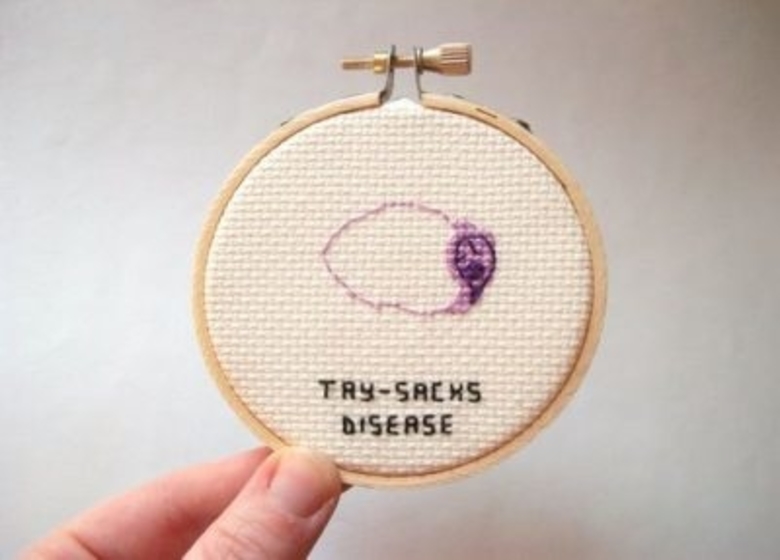Tay-Sachs Disease In Children
After birth, some babies may develop a rare genetic disorder called’ Tay-Sachs’ that gradually destroys neurons or nerve cells in the brain and spinal cord and often leads to impairment or death. It is not a curable disease. Genetic testing, however, can be done early in pregnancy to screen for it and take action that is necessary. Researchers are studying transplants of bone marrow or gene therapy in order to find a future cure for this disorder.
What Is Tay-Sachs Disease?
Tay-Sachs is a seldom transmitted parents-to-child disorder. It is caused by the lack of an enzyme which helps to break down fatty substances. These fatty substances, known as gangliosides, increase the brain’s toxicity and impact the nerve cell’s function. The child loses muscle control as the disease progresses. This ultimately results in blindness, paralysis, and death.
Doctors strongly recommend genetic testing and genetic counseling if you have a family history of Tay – Sachs disease or are a member of a high – risk group and plan to have children.
Various forms of Tay Sachs Disease :
The disease of Tay – Sachs can have many forms. Its most common form is infantile, which usually occurs in babies around 6 months of age after which their development slackens. Babies with a severe childhood disorder form usually only survive to early childhood.
There are quite rare other forms of this disease. Symptoms of Tay-Sachs disease may occur between 2 and 5 years of age in adolescence, but they are generally milder than those shown during childhood. Such a condition is called hexosaminidase juvenile. The disease progression is quite slow and can lead to death between 5 and 15 years at any time. This disorder also has a late-onset juvenile or adult form. This usually appears during adulthood symptoms. It is, however, extremely rare and formally mild. People with this disorder may have different life expectancies from individual to individual.
Chronic hexosaminidase is another variation of the disease. The symptoms may begin to show about 5 years of age and may not occur until 20 to 30 years of age. In shape, it’s milder.
Symptoms Of Tay-Sachs Disease:
Usually, a child starts showing symptoms in the most common form by about 6 months of age. The following may include signs and symptoms of Tay – Sachs disease:
- Loss of motor skills, as well as turning over, crawl and sitting up
- Exaggerated reactions once the baby hears loud noises
- Seizures
- Vision and hearing impairment
- “Cherry-red” spots within the eyes Muscle weakness
- Movement issues
When To See A Physician:
If your child has any of the above – mentioned signs or symptoms, schedule an appointment with the doctor of your child.
Causes Of Tay-Sachs Disease:
- A mutation or change in the gene HEXA (a hexosaminidase A subunit) prevents the body from producing the enzyme hexosaminidase A. Lack of this enzyme causes gangliosides in the brain to build up fats that affect the functioning of the nervous system and cause the disease.
- If a child inherits two defective genes, one from his father and mother, Tay-Sachs is developed. He turns out to be a carrier if a child gets one mutated gene and the other normal gene. The disease may not affect him, but he will carry the flawed gene and is likely to pass it down to his offspring.
Risk factors Of Tay-Sachs Disease:
Risk factors for Tay-Sachs disease embrace having ancestors from:
Eastern and Central European Jewish communities (Ashkenazi Jews)
Certain French Canadian communities in Quebec
Old Order Amish community in Pennsylvania
Cajun community of Louisiana
Diagnosis Of Tay-Sachs Disease:
Prenatal tests such as chorionic villus sampling (CVS) are usually performed between 10 to 12 weeks of gestation involving the removal of some cell samples from the placenta through the abdomen or vagina, which can help in the diagnosis of Tay-Sachs disease. The test involves taking some liquid, which encloses the fetus with a needle through the mom’s belly. Amniocentesis is a further test that is usually done about 15 to 20 weeks after gestation. The incidence of the disorder may also be found in this test. The genetic testing of the parents is performed to determine whether the Tay-Sachs disease carriers are involved.
If a baby appears to show the symptoms of the disease, a doctor may first inquire about the history of the family. He may also conduct a child’s physical eye exam to check for a cherry-red spot, which is one of’ Tay-Sachs’ disorder’s characteristic symptoms. He may suggest a baby’s tissue or blood sample enzyme analysis that examines the existence and levels of’ hexosaminidase A’ to confirm the disorder’s presence. The levels in Tay-Sachs disease are absent or decreased.
Treatment Of Tay – Sachs Disease:
Tay-Sachs has no cure. Treatment usually involves keeping the child comfortable. Palliative care may include pain medication, anti-epileptics to control seizures, physical therapy, feeding tubes, and respiratory care to reduce the buildup of mucus in the lungs.
Also important is emotional support for the family. You can help cope with the search for support groups. It is emotionally challenging to take care of a sick child and it can be comforting to talk to other families fighting the same disease.
Prevention Of Tay-Sachs Disease:
You can have a blood test analyzing your genes or Hex-A protein levels in your blood to tell you if you’re a carrier. A genetic consultant can help them review the possibilities to reduce the chances of a baby with Tay-Sachs if two people are planning to have children knowing that they are both carriers.
It is advisable to go for genetic counseling and genetic testing in case you have a family medical history of Tay-Sachs disorder and intend to have children. Many palliative care programmes, helping to provide necessary support and quality of life for babies.
Also Read: Know: What Is Reye’s syndrome In Children













